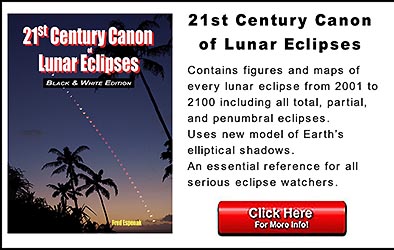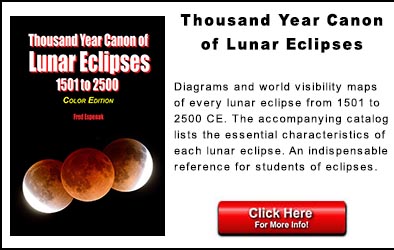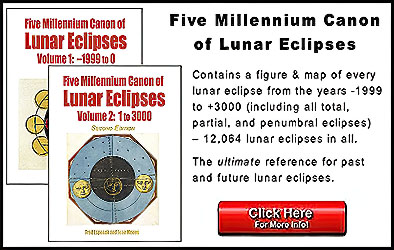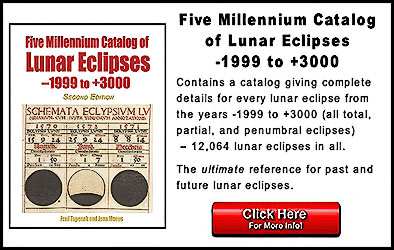The Moon's apparent magnitude during the total phase of a lunar eclipse can be estimated with a pair of binoculars. The idea here is to use the binoculars 'backwards' - look at the Moon through the objective end of the binoculars with the eyepiece end pointed towards the Moon. This method will reduce size of the Moon's image so that it appears star-like. The brightness of the Moon through the inverted binoculars can then be compared to the brightness of nearby stars that are viewed without binoculars.
This measurement should be done at mid-totality when the Moon is deepest in Earth's umbral shadow. Use a star atlas to identify nearby stars and record which star the Moon appears closest to in brightness. Taking the star's apparent magnitude as a starting point, the Moon's apparent magnitude must be corrected for a factor introduced by the binoculars. The corrections for 8x, 7x, and 6x binoculars are 4.5, 4.2, and 3.9 magnitudes, respectively. The correction factor should be subtracted from the comparison star’s magnitude to get the Moon's estimated magnitude during totality.
For example, if the totally eclipsed Moon through a pair of inverted 7x35 binoculars appears as bright as Altair (mv = +0.77), the Moon's estimated apparent magnitude is -3.43 (= 0.77 - 4.2).
Dr. Richard A. Keen (University of Colorado) has been using these measurements to estimate the amount of volcanically produced stratospheric aerosols in Earth's atmosphere (Keen, 1983). He welcomes measurements of the Moon's brightness during upcoming total lunar eclipses. He can be reached at [email protected].
Note: The older Danjon Scale of Lunar Eclipse Brightness is a more subjective way of estimating the Moon's brightness during the total phase of a lunar eclipse.
References
- Keen, R. A., "Volcanic Aerosols and Lunar Eclipses", Science, vol. 222, p. 1011-1013, Dec. 2, 1983 (summary in Sky & Telescope, June 1984, page 512)
The following links are for more recent papers presented in 2015, 2016, and 2017 at the NOAA ESRL Global Monitoring Annual Conferences, Boulder, Colorado.
- 2017 “Two Centuries of Volcanic Aerosols Derived from Lunar Eclipse Records, 1805-2015”. NOAA ESRL Global Monitoring Annual Conference May 23-24, 2017, Boulder, Colorado
- 2016 "The Calbuco Chronicle: Volcanic aerosols in the post-Pinatubo stratosphere”. NOAA ESRL Global Monitoring Annual Conference May 17-18, 2016, Boulder, Colorado
- 2015 “Volcanic Aerosol Forcing of the Global Climate Derived from Lunar Eclipse Observations, 1979-2014”.
NOAA ESRL Global Monitoring Annual Conference May 19-20, 2015, Boulder, Colorado
- Abstract: www.esrl.noaa.gov/gmd/publications/annual_meetings/2015/abstracts/100-150401-A.pdf
- Poster: www.esrl.noaa.gov/gmd/publications/annual_meetings/2015/posters/P-48.pdf




